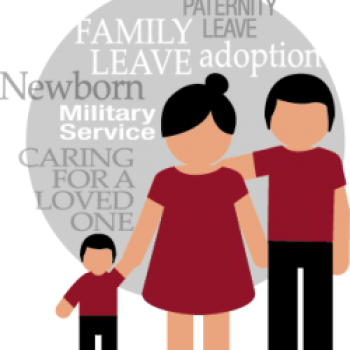Starting January 1, 2018, all private employers, regardless of employer size, with employees working in New York State for 30 or more days in a calendar year, must have Paid Family Leave coverage for their employees.
What is Paid Family Leave?
As described by New York State, Paid Family Leave provides partial wage replacement and job protection to eligible employees for paid time off from work:
- To bond with and care for a newborn, adopted or fostered child during the first 12 months following the birth, adoption or fostering of the child.
- To tend to obligations arising from a spouse, child, domestic partner or parent who has been notified of an order of active military duty.
- To care for a close relative with a serious health condition.
A “close relative” is defined as: an employee’s spouse, domestic partner, child, parent, parent in-law, grandparent, or grandchild.
An employee may be granted paid family leave only once in a 12-month period, which will be measured forward from the date the employee’s first Paid Family Leave begins.
Unlike federal Family and Medical Leave Act leave, employees may not use paid family leave for their own serious health condition.
Who is Eligible?
Employees are eligible:
- After 26 work weeks if they work a regular schedule of twenty or more hours per week; or
- After 175 work days if they work a regular schedule of fewer than twenty hours per week.
May Employees Opt-Out?
In certain circumstances, temporary or seasonal employees may opt-out of such benefits.
How Much Leave May Employees Take and How Much Do They Receive?
The amount of paid leave and the amount of pay, will be staggered from years 2018 to 2021, eventually increasing from 8 to 12 weeks of paid family leave, as follows:
| Benefits Phase-in Table | |||
| Year | Weeks Available in Any 52-Week Period | Max % of Employee Average Weekly Wage | Cap % of State Average Weekly Wage |
| 1/1/2018 | 8 | 50% | 50% |
| 1/1/2019 | 10 | 55% | 55% |
| 1/1/2020 | 10 | 60% | 60% |
| 1/1/2021 | 12 | 67% | 67% |
Starting January 1, 2018, eligible employees may take 8 weeks of Family Leave during any 52-week period, beginning on the first day they take paid family leave. They may be eligible to receive 50% of their salary during their 8 weeks of leave, up to (but not more than) the state average weekly wage.
As of January 1, 2019, eligible employees may take 10 weeks of paid family leave and will receive 55% of their salary during the 10 weeks of leave, up to the state average weekly wage at that time. If weekly earnings are greater than the state average weekly wage, earnings during the leave period will be capped at 55%.
As of January 1, 2020, eligible employees may take 10 weeks of paid family leave and will receive 60% of their salary during the 10 weeks of leave. If weekly earnings are greater than the state average weekly wage, earnings during the leave period will be capped at 60%.
When fully phased-in on January 1, 2021, employees will be eligible to take 12 weeks of paid family leave and receive 67% of their salary during their 12 weeks of leave. If their weekly earnings are greater than the state average weekly wage, their earnings during their leave period will be capped at 67% of the state average weekly wage level.
Who Pays for Paid Family Leave?
The program is included as a rider to an employer’s short-term disability policy, but will be fully funded by employees through payroll deductions each pay period, which employers could have begun making as early as July, 2017, unless the employer chooses to pay the premium itself.
The New York State Department of Financial Services has established the employee contribution for coverage beginning January 1, 2018, to be 0.126% of an employee’s weekly wage, up to and not to exceed the statewide average weekly wage, currently $1,305. That percentage will be deducted each pay period from an employee’s paycheck to pay for the premium for this insurance benefit.
A maximum rate of employees’ contribution will be established each year.
Does the Law Apply to Non-Profit Organizations?
Yes, generally, but coverage restrictions for disability benefits for employees of non-profit or religious institutions also apply to Paid Family Leave. As you may know, “[r]eligious, charitable or educational institutions operating on a non-profit basis are required to obtain disability benefits insurance or to provide disability benefits through approved self-insurance to all of their employees, with exceptions, as noted below, if they employ one or more employees: …a duly ordained, commissioned or licensed minister, priest or rabbi; a sexton; a christian science reader; a member of a religious order.
Also excluded from mandatory coverage are persons engaged in a professional or teaching capacity in or for a “religious, charitable or educational institution”; or an executive officer of an incorporated religious, charitable or educational institution; or persons participating in or receiving rehabilitative services in a sheltered workshop operated by such institutions under a certificate issued by the U.S. Department of Labor; or volunteers in or for such institutions; or recipients of charitable aid from a religious or charitable institution who perform work in or for such institution which is incidental to or in return for the aid conferred, and not under an expressed contract of hire.”
How Much Notice Must an Employee Provide to His/Her Employer Before Taking Leave?
If an employee’s Paid Family Leave is foreseeable, that employee must provide at least 30 days’ advance notice before the leave begins.
May an Employer Require Documentation of the Need for Paid Family Leave?
Yes, an employer may require a certification from a health care provider treating the employee’s family member or, if the leave is following birth of a child, the health care provider treating the mother of the child. For adoption and foster care, different types of documentation will be needed. Employees taking Paid Family Leave for a qualifying military event must provide copies of Duty Papers or other supporting documentation.
Do Employers Have an Obligation to Continue Health Insurance Benefits and Leave the Position Open During an Employee’s Paid Family Leave?
Yes, employers must continue employees’ health insurance benefits during the Paid Family Leave so long as employees continue to pay their share of health insurance premiums for coverage during their absence. Such employee contributions will continue to be paid through payroll deductions.
The law requires employers to restore employees to the same position or a comparable one if the employee returns to work after paid family leave. Failure to do so may result in claims of unlawful discrimination or retaliation.
What Should Employers Do Now?
In view of this impending law, New York employers should contact their disability insurance carrier if they have not done so already to obtain paid family leave insurance, set up employee payroll deductions for these benefits and inform employees in writing about the payroll deductions and their rights under the law, create written policies addressing paid family leave, post a mandatory notice in the workplace (as with workers’ compensation and disability benefits), and train managers on the law’s new requirements. Copies of the Paid Family Leave forms and the mandatory poster can be found at: https://www.ny.gov/new-york-state-paid-family-leave/paid-family-leave-forms-employees-employers-and-insurance-carriers.
If you have any questions about this law’s application to your workplace, please contact Lisa M. Brauner, Head of Perlman & Perlman LLP’s employment practice, at 212-889-0575, lisa@perlmanandperlman.com.
-
Perlman & Perlmanhttps://www.staging-perlmanandperlman.com/author/nancyisrael/
-
Perlman & Perlmanhttps://www.staging-perlmanandperlman.com/author/nancyisrael/
-
Perlman & Perlmanhttps://www.staging-perlmanandperlman.com/author/nancyisrael/
-
Perlman & Perlmanhttps://www.staging-perlmanandperlman.com/author/nancyisrael/












